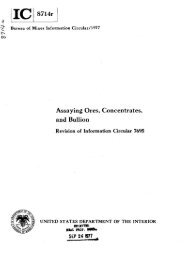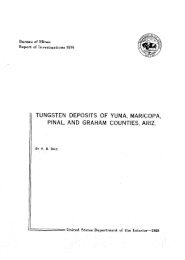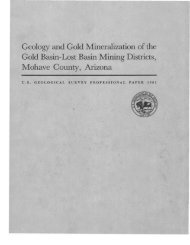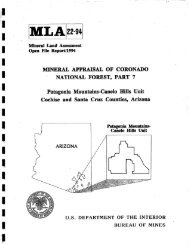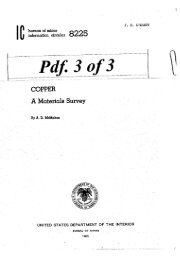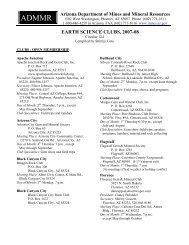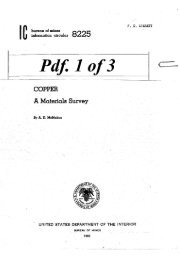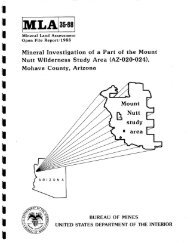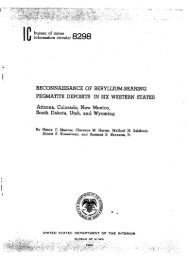MLA 23-94 - State of Arizona Department of Mines and Mineral ...
MLA 23-94 - State of Arizona Department of Mines and Mineral ...
MLA 23-94 - State of Arizona Department of Mines and Mineral ...
You also want an ePaper? Increase the reach of your titles
YUMPU automatically turns print PDFs into web optimized ePapers that Google loves.
Margarita Mine (pl. 1, site 1 ), the best delineated <strong>of</strong> the flat, silica-zone gold deposits,contains 0.44 million st <strong>of</strong> 0.072 oz Au/st in a high-grade zone, <strong>and</strong> 0.52 million st <strong>of</strong> 0.046oz Au/st, overall. Experimental recovery <strong>of</strong> gold at the mill is high (> 90%). USBM modelingsuggests a negative NPV 3 <strong>of</strong> -$18.4 million over the mine life. Mining the entire deposit,including the lower-grade material, simply detracts further from the economics. Low deposittonnage <strong>and</strong> the current price <strong>of</strong> gold are major negative economic factors, as are capitalrequirements. At the current price <strong>of</strong> gold, the deposit would be a break-even economicventure if approximately 32.5 million st <strong>of</strong> 0.072 oz Au/st were discovered (USBM, 19<strong>94</strong>a,p. 9-10).The White Gold/West claims encompass three flat, silica-zone gold deposits (pl. 1, sites2-4), 16 less-well-delineated prospects, <strong>and</strong> two gold geochemical anomalies (pl. 1, sites 5-22). The Central zone prospect (pl. 1, site 3) contains 1 million st <strong>of</strong> 0.033 oz Au/st <strong>and</strong> 0.4million st <strong>of</strong> 0.050 oz Au/st; industry data are not available for the other two delineateddeposits (sites 2, 4, pl. 1). More tons <strong>of</strong> higher-grade gold are required for this area to beeconomic for development. Exploration at the other 16gold prospects <strong>and</strong> two geochemicalanomalies, about which little data are available, may delineate the needed additional tonnage.One <strong>of</strong> the 16 prospects, known as the Pedro prospect (pl. 1, site 17) could possibly contain1 million st or more <strong>of</strong> auriferous rock, but grades delineated to date are low (0.05 oz Au/st,maximum) (USBM, 19<strong>94</strong>a, p. 10-16).Another 14 flat, auriferous, silica zones are in the south-central part <strong>of</strong> theManagement Unit (pl. 1, sites <strong>23</strong>-36). Included in this group are Old Glory Mine, RagnarocMine, <strong>and</strong> Austerlitz Mine. Few data are known concerning tonnage <strong>and</strong> gold grade <strong>of</strong> thezones. Most previous work has focused on auriferous veining, a common geologic occurrencein the flat silica zones. Study <strong>of</strong> the veining is misrepresentative because the veins haveelevated gold grades but much lower tonnages than the flat, predominantly massive, silicazones (USBM, 19<strong>94</strong>a, p. 11-16).Future prospecting for gold at some <strong>of</strong> these sites should be expected. A jump in theprice <strong>of</strong> gold to a recent yearly average high ($438/oz, experienced in 1988) would spur anincrease in activity.USBM modeling <strong>of</strong> the auriferous breccia zones (not shown on pl. 1), which are lowtonnage,numerous, oxidized, <strong>and</strong> contain free gold, suggest that no deposit <strong>of</strong> this type hasthe combination <strong>of</strong> tonnage <strong>and</strong> grade to be economically developed, though some <strong>of</strong> thelower-angle deposits (45 ° <strong>of</strong> dip or less) may be more economical to develop in the future iftechnological improvements in mining <strong>of</strong> thin, low-angle veins continue (described inLaFlamme <strong>and</strong> others, 19<strong>94</strong>). Auriferous quartz-sulfide veins are considered even more3 NPV is "net present value", calculated at a 15% ROR (rate <strong>of</strong> return),



